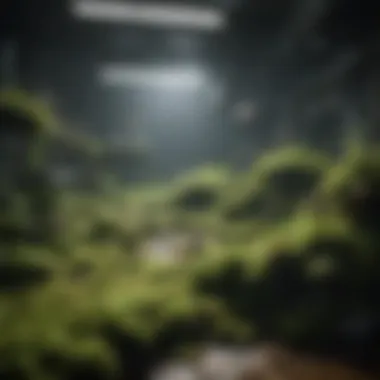Moss Carbon Sequestration: An In-Depth Analysis


Overview of Research Topic
Brief Background and Context
Mosses are small, non-vascular plants that play a crucial role in many ecosystems. With over 12,000 species acknowledged, mosses thrive in diverse environments, from forests to tundra. Despite their simplicity, these organisms possess remarkable capabilities for carbon sequestration. As climate change intensifies, understanding the ecological functions of moss is essential for effective environmental management.
The process of carbon sequestration refers to the capture and storage of carbon dioxide, a greenhouse gas contributing to global warming. Mosses absorb carbon through photosynthesis and retain it in their biomass and the soil they inhabit. Their ability to sequester carbon makes them valuable allies in the fight against climate change. As we emphasize the importance of nature-based solutions, moss will emerge as a focal point in carbon management strategies.
Importance in Current Scientific Landscape
The significance of mosses in carbon cycling has gained recognition among scientists and policymakers alike. Recent studies indicate that mosses could play a key role in achieving net-zero carbon emissions. Researchers are looking into various aspects of moss biology and ecology to optimize their use in carbon capture strategies. The ongoing work in this area reflects a growing acknowledgment that leveraging natural processes can complement technological measures aimed at reducing atmospheric carbon levels.
In the scientific landscape, the integration of moss in climate mitigation strategies prompts a reevaluation of how ecosystems can contribute to carbon management. Case studies have surfaced, demonstrating successful moss cultivation practices that enhance carbon capture, thereby encouraging a more sustainable approach to land use. As mosses sequester significant carbon amounts, they must be incorporated into broader environmental policies.
Methodology
Research Design and Approach
This analysis employs a multi-disciplinary approach, integrating findings from biology, ecology, and environmental science. A review of current literature identifies key biological processes within mosses that contribute to carbon sequestration. The research also examines environmental conditions that enhance or detract from moss effectiveness in carbon capture, establishing a comprehensive understanding that informs best practices in moss cultivation.
Data Collection Techniques
Data for this analysis is drawn from various sources, including peer-reviewed journals, case studies, and expert interviews. Field studies are cited to demonstrate real-world applications of moss carbon sequestration. Additionally, climate models are referenced to understand the potential impacts of moss cultivation on global carbon budgets. This rich dataset forms the foundation for drawing conclusions about the importance of moss in climate solutions.
Foreword to Carbon Sequestration
Carbon sequestration refers to the processes that capture and store carbon dioxide (CO2) from the atmosphere. This concept is increasingly important in addressing climate change. As CO2 is a significant greenhouse gas, reducing its concentrations is crucial for controlling global warming. In this article, we explore various aspects of carbon sequestration, specifically focusing on the role of moss in this process.
Understanding carbon sequestration helps grasp the broader implications of greenhouse gas management. It highlights the importance of natural systems in mitigating climate impact and ensuring ecosystem stability. Key elements to consider include
- Natural vs. artificial sequestration: Natural processes like photosynthesis play a vital role, whereas technological solutions, although promising, are often costly and unproven at a large scale.
- Ecosystem health: Effective carbon sequestration benefits not just climate goals but also biodiversity and soil health.
- Climate policies: Integrating carbon sequestration into official policies supports sustainable practices that are impactful over time.
The relevance of carbon sequestration cannot be overstated. Recognizing how different organisms, including moss, contribute can lead to more effective strategies for carbon management and environmental restoration.
Definition and Importance
At a fundamental level, carbon sequestration is the process of capturing carbon dioxide and storing it to mitigate the effects of climate change. This can occur through natural processes, particularly in ecosystems such as forests, wetlands, and moss habitats. Carbon can be sequestered in both biomass and soil.
The importance of identifying and utilizing effective carbon sinks is paramount as global temperatures escalate. Mosses, while often overlooked, have a significant role to play in this arena. They possess unique characteristics that allow them to absorb carbon efficiently. In regions where traditional vegetation may struggle, moss can thrive, thereby contributing to carbon storage.
Historical Context
Historically, carbon sequestration has taken many forms, tracing back to natural processes that have been in place for millennia. Scientists have long understood that plants absorb CO2 during photosynthesis; this process forms the foundation for terrestrial carbon storage. However, mosses have received comparatively little attention until more recent years.
In ancient ecosystems, mosses played a critical role in carbon cycling. They were essential to the formation of peatlands, which are significant carbon stores today. Yet, as scientific understanding evolved, focus shifted predominantly to larger tree species and forest environments. It wasn't until more contemporary climate discussions that the potential of moss as a carbon sink began to gain recognition once again. This shift in perspective reflects a broader movement towards holistic environmental management.
Moss: An Overview
Understanding moss is essential for comprehending its role in carbon sequestration. Moss occupies a unique ecological niche, serving as a crucial component of various ecosystems. With its widespread presence in both terrestrial and aquatic environments, moss contributes significantly to the carbon cycle. This section discusses the different types and biological characteristics of moss.
Types of Mosses
Mosses can be categorized into several types based on their environments and physiological traits. The major types include:
- Sphagnum Moss: This type is predominantly found in bogs and wetlands. Sphagnum acts as a vast carbon reservoir, capable of sequestering carbon over long periods.
- Polytrichum: Known for its tall growth, Polytrichum is often found in moist forests. It contributes to soil formation and carbon stability.
- Calliergon: This group usually thrives in aquatic environments or near water bodies. Calliergon plays a role in nutrient cycling and carbon capture in these habitats.
Each of these types has specific adaptations that enable them to survive and grow under various environmental conditions. Their abundance and diversity illustrate the importance of moss in ecosystems.
Biological Characteristics
Mosses typically exhibit certain biological characteristics that enhance their carbon sequestration capabilities. They are non-vascular plants, meaning they lack the complex water-conducting tissues that other plants have. This feature allows them to absorb moisture and nutrients directly from their surroundings. Notable characteristics include:
- Photosynthetic Efficiency: Mosses have a high surface area-to-volume ratio, allowing them to maximize light absorption for photosynthesis. This process is fundamental for capturing carbon dioxide from the atmosphere.
- Survival Mechanisms: Mosses possess remarkable resilience to unfavorable conditions. They can tolerate droughts and extreme temperatures by becoming dormant, reducing their metabolic activity until favorable conditions return.
- Symbiotic Relationships: Mosses often develop relationships with various microorganisms. These interactions enhance nutrient availability, further boosting their capacity for carbon capture.
Mosses are not only carbon sinks but also play a vital role in environmental health and biodiversity.
Mechanisms of Moss Carbon Sequestration
Understanding the mechanisms of moss carbon sequestration is essential for appreciating how these organisms contribute to climate stability. Mosses interact uniquely with their surroundings. Their ability to absorb carbon dioxide and retain it plays a vital role in carbon capture strategies. This section discusses the biological processes that facilitate carbon absorption and examines the interactions between mosses and their substrates. Importantly, these mechanisms are both natural and synergetic, requiring specific environmental conditions to function most effectively.
Photosynthesis in Mosses
Photosynthesis in mosses is a fundamental process that enables these organisms to convert light energy into chemical energy. Unlike larger plants, mosses operate without specialized vascular systems. Instead, their structure permits efficient gas exchange. Moss cells contain chlorophyll, which captures sunlight and facilitates photosynthesis. Remarkably, mosses can thrive in low-light environments, making them adaptable to shaded regions.
Mosses utilize sunlight to convert carbon dioxide from the atmosphere into organic compounds. This process is integral to their growth and sustenance. Because mosses are often found in dense mats, their collective photosynthetic activity can contribute significantly to local carbon sequestration. Oxygen, a byproduct of photosynthesis, enhances the air quality, illustrating another indirect benefit of moss cover.
Soil and Nutrient Interaction


Mosses also engage in critical interactions with soil and nutrients. They play a noteworthy role in soil formation by creating a layer that retains moisture and organic matter. This layer improves soil fertility, promoting a suitable habitat for various microorganisms that further enhance soil health. As mosses die and decompose, they replenish the nutrient bank, contributing organic material to the soil. Thus, the presence of mosses can lead to an increase in carbon storage, further supporting their role as effective carbon sinks.
Mosses can influence nutrient cycles, absorbing and retaining essential minerals such as nitrogen and phosphorus. These interactions lead to the development of microhabitats that support diverse biological communities. Moreover, when moss biomass accumulates, it sequesters carbon both in the plant material and the associated soil.
In summary, the mechanisms of carbon sequestration facilitated by mosses demonstrate their ecological significance. From their unique photosynthetic capabilities to their enriching interactions with the soil, mosses offer substantial contributions to carbon management. The following sections will provide insights into the environmental factors that influence these mechanisms.
Environmental Factors Influencing Moss Sequestration
Understanding the environmental factors influencing moss carbon sequestration is crucial for maximizing the effectiveness of moss as a natural tool in combating climate change. Various elements contribute significantly to the efficiency with which moss captures carbon. These factors include moisture and humidity levels, as well as temperature and light availability. Harnessing these elements can enhance the capacity of moss to sequester carbon, making it a viable option for environmental management.
Moisture and Humidity Levels
Mosses thrive in environments where moisture is abundant. The role of moisture cannot be overstated. High humidity levels directly impact the physiological processes of mosses, particularly photosynthesis and respiration. When there is sufficient moisture, mosses can absorb water through their leaves, which is essential for their metabolic functions. This leads to more effective carbon uptake.
Furthermore, the retention of moisture in the ecosystems where mosses grow can create a favorable environment for other organisms, bolstering the entire ecosystem's carbon storage capacity. In areas such as wetlands, where moisture levels are high, mosses not only sequester carbon but also contribute to increased biodiversity.
Research indicates that mosses can retain up to 20 times their weight in water. This remarkable ability enables them to create microhabitats that support various plant and animal species, thus promoting overall ecological balance.
Temperature and Light Availability
Temperature conditions play another pivotal role in moss carbon sequestration. Typically, mosses prefer cool to moderate temperatures, which correspond to higher rates of photosynthesis. Light availability is equally essential; sufficient sunlight enhances the photosynthetic capacity, allowing mosses to capture more carbon. In shaded environments, where mosses often flourish, they adapt to lower light conditions, but their carbon uptake may not be as efficient compared to more illuminated areas.
It is important to consider that extremes in temperature, whether excessively high or low, can stress moss populations and hinder their growth. Recent studies suggest that a stable temperature range along with favorable light conditions can significantly increase the carbon sequestration potential of mosses.
"Mosses are sensitive to environmental changes; their growth and carbon sequestration capabilities are indicators of ecosystem health."
In summary, understanding both moisture and temperature is essential for optimizing moss cultivation as a method for carbon management. As researchers and policymakers consider moss for broader applications in carbon sequestration, focusing on these environmental factors will enhance strategies for combating climate change.
Comparative Effectiveness: Moss vs. Other Vegetation
Moss plays a significant role in carbon sequestration. It serves as an efficient and often underappreciated carbon sink. This section highlights the advantages of moss compared to other types of vegetation. Each type of plant has its own unique traits and capacities for absorbing carbon. However, mosses have certain characteristics that make them particularly effective for this purpose.
Moss as a Carbon Sink
Mosses are highly effective at capturing and storing carbon dioxide from the atmosphere. This ability derives from their unique biology and ecology.
- Surface Area: Mosses have a high surface area relative to their biomass. Their structure allows them to absorb carbon more directly from the air.
- Moist Environment: Many moss species thrive in wet or moist conditions, which enables them to maintain high levels of photosynthesis for extended periods. This, in turn, promotes ongoing carbon capture efforts.
- Decomposition Resistance: The decomposition of moss is slower compared to other plants. When they die, they can entrap carbon within the soil instead of releasing it back into the atmosphere quickly.
As a result, moss can sequester significant amounts of carbon in a relatively short time frame, making it a valuable asset in the fight against climate change.
Regenerative Potential
The regenerative potential of moss is another factor that differentiates it from other vegetation. This characteristic includes how fast they can recover after disturbances and their ability to grow in challenging conditions.
- Resilience: Mosses can endure extreme conditions such as drought and heavy shade. Their capacity to regenerate quickly after such events allows them to contribute to carbon storage over time.
- Pioneer Species: Moss often acts as a pioneer species, establishing itself in disturbed or bare soils. By doing so, they create a microhabitat that supports other plant life as well.
- Soil Formation: Moss aids in soil formation by contributing organic matter. This process enhances soil health and increases its carbon storage capacity, thus supporting a cycle of regeneration that benefits the entire ecosystem.
Case Studies of Moss Carbon Sequestration
Understanding the practical applications and effectiveness of moss in carbon sequestration requires a look into various case studies. This section reveals how different environments can benefit from moss, showcasing both successful initiatives and the findings of significant research. The insights from these real-world examples help to underline the potential of moss in mitigating climate change effects.
Significant Research Studies
Several research studies have explored moss’s capabilities in carbon capture. One notable study conducted by Dr. Lesley Smith focused on the Sphagnum genus of moss, which displays exceptional carbon storage abilities. The study revealed that Sphagnum can sequester up to 50 tons of carbon per hectare per year. This finding is critical, as it confirms that certain moss species are not only effective in absorbing carbon dioxide but also play a vital role in long-term carbon storage within peatland ecosystems.
Another significant study by the University of Maryland highlighted the impact of moss in urban settings. Moss was found to accumulate carbon more efficiently in cities with high pollution levels. This adaptation might be due to the unique metabolic processes of moss that allow it to thrive in withstanding various environmental stresses.
Furthermore, investigations into the role moss plays in restoration ecology have proven valuable. Research shows that integrating moss into restoration projects enhances soil quality and promotes biodiversity. These studies collectively paint a hopeful picture for using moss in carbon management strategies across different ecosystems.
Successful Implementation in Ecosystems
Moss cultivation has seen successful implementation in various ecological restoration projects. One practical application is in wetlands. For instance, the Okeefenokee Swamp restoration incorporates mosses to improve hydrology and improve carbon sequestering abilities. The planted Sphagnum not only enhances habitat viability for wildlife but also contributes to the swamp's overall health and carbon capture potential.
In urban landscapes, cities like San Francisco have developed green roofs featuring moss. These installations not only serve aesthetics but also assist in stormwater management and reduce urban heat effects. Studies reveal that these green roofs can lower temperatures by several degrees, which indirectly supports enhanced carbon assimilation by surrounding flora.
Moss has also been utilized in mining rehabilitation projects. After mining activities, large areas lose vegetation cover and store much less carbon. Introducing moss species in these environments helps to stabilize soil, prevent erosion, and aid in the ecological balance by restoring carbon storage capacities.
The practical implementations of moss in varied environments highlight its adaptability and efficiency as a tool for carbon sequestration.
The effectiveness of these projects suggests that moss can be a crucial component in strategies aimed at reducing atmospheric carbon levels. It illustrates how ecological interventions utilizing moss can lead to improved environmental outcomes on multiple fronts.
Moss Cultivation Strategies for Carbon Management
Moss cultivation strategies are essential for effective carbon management in ecosystems. These strategies not only enhance carbon sequestration but also contribute to broader environmental sustainability. By focusing on integrating moss into various landscapes, we can leverage its unique biological characteristics to mitigate climate change impacts.
The importance of moss cultivation lies in its ability to thrive in diverse environments while capturing carbon dioxide. Mosses require less water and nutrients compared to conventional plants. These traits make them ideal for regions where traditional vegetation struggles to grow. Thus, promoting moss can help restore degraded land and improve carbon stocks in those areas.
Key benefits of these strategies include:
- Enhanced Carbon Storage: Mosses have a high rate of photosynthesis, allowing them to absorb significant amounts of CO2.
- Improvement of Microhabitats: Mosses provide a habitat for various organisms, promoting biodiversity.
- Soil Health: They contribute to soil structure and fertility, supporting further plant growth.


However, several considerations must be addressed when developing effective moss cultivation strategies. Firstly, understanding local soil types, climate, and moisture levels is vital. Secondly, the selection of appropriate moss species should align with regional environmental conditions. These steps ensure successful integration and sustainability of moss cultivation.
Techniques in Cultivation
Several cultivation techniques exist that maximize the potential of moss in carbon management. Among these techniques, one popular method includes the use of moss carpets. These moss carpets are cultivated in controlled environments or nursery settings before they are transplanted into the target habitat.
Effective techniques include:
- Cloning: This method involves propagating moss from existing species, increasing genetic diversity.
- Transplanting: Moving moss from a donor area to a restoration site can rapidly establish growth.
- Hydroponic Systems: Using water-based solutions allows for maximized growth potential in a controlled environment.
Each method has its advantages and can be chosen based on specific project goals and ecological considerations.
Integration into Urban Green Spaces
Integrating moss into urban green spaces is a promising approach to enhance carbon sequestration. Urban areas are often characterized by limited vegetation and high carbon emissions. By introducing moss, we can create green roofs, living walls, and even landscaping solutions that significantly improve city ecosystems.
The integration of moss into urban settings can provide benefits such as:
- Aesthetic Appeal: Mosses can enhance the visual quality of urban landscapes.
- Noise Reduction: Mosses can help absorb sound, improving the acoustic environment.
- Air Quality Improvement: Acting as natural air filters, mosses can trap pollutants and improve urban air quality.
The strategic placement of moss in urban areas enhances the local environment while contributing to overall carbon management strategies. As cities face increasing pressure from climate change, incorporating moss can provide a sustainable solution.
The Role of Moss in Biodiversity
Moss plays a crucial role in maintaining biodiversity within ecosystems. Its presence influences various aspects of habitats, contributing to both microbial life and larger organisms. The ability of moss to create unique habitats allows for a diverse array of species to thrive, underscoring its significance in ecological studies and conservation efforts. This section will explore two main areas where moss contributes to biodiversity: the support of microhabitats and the promotion of soil health.
Supporting Microhabitats
Mosses provide a vital support system for numerous small organisms. They offer shelter and protection for insects, such as beetles and various larvae. The thicket formed by dense moss can also serve as a breeding ground for amphibians. In forested areas, moss can retain moisture in tree canopies, allowing for a microhabitat that provides necessary humidity for various species.
Additionally, moss captures and stores rainwater, creating a habitat that supports various aquatic microorganisms. These microorganisms play a significant role in nutrient cycling and supporting higher trophic levels in the food chain. Mosses also create a layer of organic matter that enriches the substrate for diverse plant life, leading to more habitat complexity.
"Mosses are not merely simple plants; they form the foundation of intricate ecological webs by providing unique habitats for countless organisms."
Promoting Soil Health
Mosses are known to promote soil health through their various interactions with soil systems. Their growth on bare surfaces contributes to soil formation. As they grow, they help in the weathering of rocks and the accumulation of organic matter. This process leads to the development of a rich layer of soil that supports other plants and contributes to overall ecosystem productivity.
The presence of moss also enhances soil moisture retention. This is essential for maintaining the health of overlying vegetation, particularly in areas subjected to drought conditions. By preventing soil erosion, moss contributes to the stability of the ecosystem, allowing diverse plant life to flourish.
Furthermore, mosses interact with soil microbes, creating a symbiotic relationship that enhances nutrient cycling. This process is essential in maintaining soil fertility and overall ecosystem health. In this way, the complexity introduced by mosses in soil systems is crucial for a balanced ecological community.
Economic Implications of Moss Carbon Sequestration
Moss carbon sequestration is more than just an environmental activity; it holds significant economic value. Understanding the financial aspects can lead to enhanced strategies for both conservation and profit. Integrating moss into carbon management offers various benefits, including cost savings, generating revenue through carbon credits, and the potential to stimulate green economies. Harnessing these economic implications can drive more widespread adoption of carbon-friendly practices.
Cost-Benefit Analysis
When assessing moss carbon sequestration, a thorough cost-benefit analysis is essential. The primary costs associated with moss cultivation include initial planting, maintenance, and monitoring. However, the investment can yield considerable returns. Consider the following points:
- Low Maintenance Requirements: Mosses generally need minimal resources compared to traditional farming, reducing ongoing operational costs.
- Improved Soil Quality: By capturing carbon, moss contributes to enhancing soil fertility, leading to better agricultural outputs.
- Ecosystem Support: Healthy moss populations support biodiversity, which can have indirect economic benefits, such as ecotourism opportunities.
In essence, while the upfront costs may appear significant, the long-term benefits often outweigh these expenses, resulting in a favorable balance for both environmental and economic factors.
Potential for Carbon Credits
The establishment of a carbon credit market brings additional economic implications for moss carbon sequestration. Organizations and individuals engaging in moss cultivation can generate carbon credits by removing carbon dioxide from the atmosphere. Here are some key considerations:
- Monetary Value of Carbon Credits: By participating in carbon credit schemes, businesses can sell their credits, generating income. This market provides an incentive for further investment in moss.
- Regulatory Compliance: As governments worldwide impose stricter emissions regulations, companies can utilize moss carbon sequestration to meet their compliance targets, potentially avoiding heavy fines.
- Corporate Responsibility: Companies can enhance their public image through sustainable practices, possibly improving customer loyalty and market share.
"The transition towards carbon-neutral business operations is not just an environmental imperative but increasingly a profitable strategy for organizations worldwide."
In summary, the economic implications of moss carbon sequestration offer a compelling case for its implementation in climate strategy. By unveiling cost-saving measures and revenue opportunities through carbon credits, stakeholders can recognize the dual benefit of financial gain coupled with ecological responsibility.
Challenges in Moss Carbon Sequestration
Moss carbon sequestration presents both opportunities and obstacles in the fight against climate change. Understanding these challenges is crucial for optimizing the role of moss in ecosystem management and enhancing its carbon capture effectiveness. As various environmental and research factors intertwine, tackling these challenges will facilitate better integration of moss into carbon management strategies.
Environmental Threats
Mosses face several environmental threats that impede their ability to sequester carbon effectively. These threats stem from both natural and anthropogenic sources, impacting their growth and health.
- Climate Change: Changing climate conditions introduce various stressors such as fluctuations in temperature and precipitation. Mosses, being sensitive to these changes, may experience reduced growth rates, directly affecting their carbon storage capacity.
- Pollution: Air and soil pollution can significantly hinder moss growth. High levels of nitrogen deposition may lead to nutrient imbalances, promoting the growth of competing vascular plants. This competition can limit the ability of mosses to thrive in their habitats.
- Habitat Loss: Deforestation, urbanization, and land-use changes directly impact moss populations. Loss of their natural habitats can disrupt local ecosystems, reducing the overall carbon sequestration capacity.
Environmental factors combine in complex ways that pose risks to moss-based carbon sequestration initiatives.
"Understanding these threats is critical for developing strategies to mitigate their effects and promote effective carbon sequestration strategies."


Research Gaps
Despite the growing interest in moss carbon sequestration, several research gaps hinder effective application and understanding of their full potential. These gaps represent opportunities for further exploration.
- Lack of Comprehensive Data: Existing studies often focus on specific moss species or ecosystems, leading to fragmented data. A broader understanding of various species and their carbon sequestration capabilities is required.
- Limited Long-term Studies: Many existing studies are short-term, preventing a full understanding of how mosses respond to changing environmental factors over time. Long-term observations are necessary to gauge their true effectiveness in diverse conditions.
- Interactions with Other Flora: There is insufficient knowledge about how moss interacts with other vegetation and their combined roles in carbon sequestration. Research into symbiotic relationships and competition can provide vital insights into optimizing moss cultivation.
- Technological Advancements: There is a need for innovative methodologies to quantify the exact carbon storage potential of mosses in varied climatic and soil conditions. This involves the application of remote sensing technologies and advanced modeling techniques.
Addressing these research gaps through collaboration among scientists and funding agencies is vital for maximizing the potential of moss in climate mitigation strategies.
Future Directions in Moss Research
The exploration of moss in carbon sequestration presents numerous avenues for further research. As climate change continues to escalate, understanding the mechanics of moss as a sustainable practice for carbon capture has gained traction. This section underscores the significance of future directions in moss research, focusing on innovative methodologies and collaborative efforts. These directions not only promise to enhance current knowledge but also lay the foundation for practical applications that could transform carbon management strategies.
Innovative Approaches to Study
Adopting novel techniques in the study of moss can unravel its potential in carbon sequestration. Researchers are increasingly using technology such as remote sensing to monitor moss growth in diverse habitats. This method offers a non-invasive way to assess environmental changes that impact moss communities, providing real-time data critical for understanding moss dynamics.
Laboratory experiments are also evolving with advanced genetic and biochemical analyses. Utilizing molecular biology techniques can help identify genes responsible for efficient carbon uptake. Such studies hold promise for genetic enhancement of moss species, boosting their ability to sequester carbon.
Field studies should also diversify to include various ecosystems, from urban environments to remote natural habitats. This comprehensive approach recognizes the adaptability of moss under differing climatic conditions. It allows researchers to compare the performance of various moss types in sequestering carbon, leading to more tailored conservation strategies.
Collaborations for Development
The path forward in moss research relies heavily on collaborative efforts among academic institutions, governments, and private sector entities. Building partnerships can facilitate the sharing of knowledge and resources, enabling large-scale research programs. For instance, universities working in climate science can collaborate with companies specializing in environmental restoration.
Additionally, engaging community organizations in research initiatives can broaden the impact of studies. Local initiatives can encourage the public to participate in moss restoration projects, fostering a greater understanding of its ecological benefits.
Public policy should also align with scientific research in promoting moss cultivation as a carbon management strategy. Stakeholders involved in environmental policies must consider the findings of upcoming research and create frameworks that support the integration of moss in conservation efforts.
"The future of moss research is not only about understanding its potential but also about applying that understanding to create actionable, sustainable solutions for climate adaptation and mitigation."
Policy Implications and Recommendations
The integration of moss into policy frameworks is increasingly recognized as a significant avenue for enhancing carbon sequestration efforts. Developing effective policies can substantially influence the management of natural resources, particularly in urban and semi-urban areas where ecosystems face intense pressure from development. Recognizing mosses as a key component of environmental strategies offers multiple benefits, ranging from improved air quality to enhanced biodiversity.
Incorporating Moss in Environmental Policies
Moss should be explicitly included in environmental policies at local, regional, and national levels. Policymakers must understand the role of moss in capturing carbon and mitigating climate change effects. Some specific elements to incorporate include:
- Regulatory frameworks: Establish standards and regulations that encourage the preservation and cultivation of mosses in various landscapes. This could mean protecting natural moss habitats or creating incentives for the installation of moss gardens in urban settings.
- Land use planning: Integrate moss cultivation in urban planning and design, thereby maximizing green spaces. These strategies may involve incorporating moss into green roofs and walls, leading to improved thermal insulation and lower energy costs.
- Public awareness campaigns: Promote education about the benefits of mosses through community outreach and engagement initiatives. This is crucial for fostering public support for moss-related projects and initiatives.
These actions collectively elevate the profile of moss in environmental discourse, fostering an ecosystem where moss and other vegetation work synergistically to combat climate change.
Advocacy for Continued Research Funding
Ongoing research into moss carbon sequestration is vital for expanding knowledge and improving implementation strategies. Therefore, advocating for continued funding in this domain is imperative.
Key aspects to consider include:
- Fund competitive research grants: Governments and institutions should create or enhance funding opportunities aimed directly at investigating various types of moss and their carbon absorption capabilities. This can lead to innovative, evidence-based practices that utilize moss more effectively.
- Support collaborative research efforts: Encouraging partnerships among universities, government agencies, and environmental organizations can foster interdisciplinary approaches. These collaborations can yield comprehensive data on mosses and their roles in ecosystems.
- Report findings effectively: Facilitate the dissemination of results to inform policy adjustments and adaptations. Former studies should constantly be evaluated, and successful techniques must be shared among practitioners for real-world application.
Continued research not only deepens the scientific community's understanding of mosses but also strengthens their position within environmental policies, making a case for their importance in future climate change strategies.
"In ensuring mosses are incorporated into environmental policies, we not only recognize their ecological value but utilize a natural ally in our fight against climate change."
By focusing on these elements, we aim to create a more robust policy framework that supports the strategic use of moss in carbon management.
Ending
The topic of conclusion holds significant weight in the examination of moss carbon sequestration. This section synthesizes the findings from earlier discussions, emphasizing not only the capacity of moss to capture and store carbon but also its ecological benefits and implications for climate policy. It is essential to recognize that moss serves as more than just a passive participant in the carbon cycle; it is an active contributor to ecosystem stability.
Summary of Findings
Moss plays a critical role in the carbon sequestration process, primarily through its unique biological structure and function. It captures carbon dioxide during photosynthesis, storing it as organic matter in soils. Research demonstrates that certain moss species can effectively store carbon for extended periods. The case studies reviewed indicate successful implementations of moss in various ecosystems, showcasing its potential to combat climate change.
This analysis reveals the multiple environmental factors influencing the efficacy of moss as a carbon sink, particularly moisture and temperature. Moreover, its ability to enhance biodiversity, support microhabitats, and improve soil health adds layers of benefits that extend beyond carbon storage.
The Importance of Continued Exploration
There is a noteworthy necessity for ongoing research into moss carbon sequestration. Ecosystems are dynamic, and as such, understanding the changing conditions that affect moss function is paramount. Increased empirical studies may uncover innovative moss cultivation strategies that can optimize its carbon capture potential.
Moreover, collaboration between researchers, policymakers, and environmental organizations is crucial to integrate findings into actionable policies. Continued funding and advocacy targeting moss research will not only enhance our understanding but also contribute to broader climate change mitigation efforts. Therefore, fostering this scientific exploration allows expansion of our strategies toward a sustainable and resilient future.
Cited Works
Cited works are the benchmark for any article discussing scientific phenomena. In the case of moss carbon sequestration, several key research papers shed light on varied aspects of this phenomenon. Critical insights can be gleaned from published journals that outline experimental setups, methods of analysis, and findings relevant to the effectiveness of moss in capturing atmospheric carbon. For instance, studies published in journals such as Ecological Applications highlight the significant impact of different moss species on soil carbon dynamics.
Moreover, academic texts examining the biochemistry involved in moss photosynthesis can further elucidate the subject. This provides a comprehensive overview, establishing a well-rounded grounding upon which further discussions can occur.
Further Reading
To gain deeper insight into the topic of moss and carbon sequestration, several resources are recommended. The Wikipedia page on Moss offers a solid introduction to the organism, outlining its biological and ecological significance.
Furthermore, platforms like Britannica provide accessible summaries of related scientific concepts that impact the understanding of carbon sequestration processes. Engaging with community discussions on platforms such as Reddit can present practical experiences and ongoing debates in the field. Networking through Facebook groups dedicated to environmental science may also link you with experts who share valuable insights and current research trends.
By exploring these references, readers can dive deeper into the intricacies of mosses and their paramount role in climate action.



